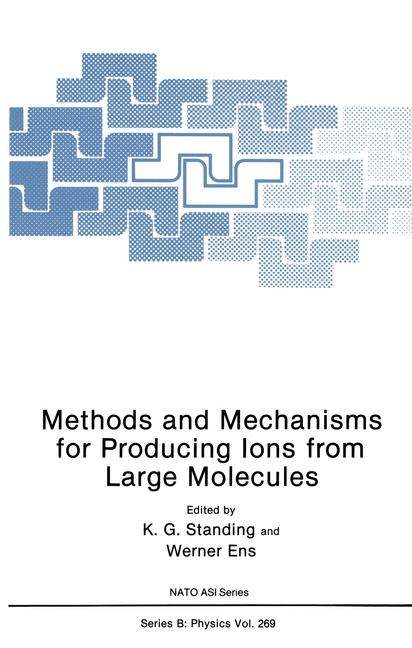
Methods and Mechanisms for Producing Ions from Large Molecules
Kluwer Academic/Plenum Publishers (Verlag)
978-0-306-44017-5 (ISBN)
- Titel ist leider vergriffen;
keine Neuauflage - Artikel merken
The Founding Fathers of Mass Spectroscopy.- MeV Particle Bombardment.- Plasma Desorption Mass Spectrometry — Achievements and Frontiers.- A New Concept: The Fast Preequilibrium Charge State of Swift Ions in Solids.- PDMS With Volatile Organic Compounds.- Competitive Peptide Adsorption to Nitrocellulose Covered Backing Material in Cf-252-Plasma Desorption Mass Spectrometry.- Charting of Rat Pituitary Peptides by Plasma Desorption and Electrospray Ionization Mass Spectrometry.- Energy and Angular Distributions of Secondary Ions Ejected from Clean Metals by MeV Ion Impact.- Different Mechanisms of Negative Ion Formation Observed with Chlorophyll-a.- Sequence Informative Fragmentation in 252Cf Plasma Desorption Mass Spectrometry.- MeV Bombardment: Theory.- Ion Formation in Electronic Sputtering from Decane.- Spatial Distribution of Biomolecules Sputtered Under Fast Heavy Ion Bombardment.- Heavy-Ion and Laser-Pulse-Induced Ejection of Large Organic Molecules.- keV Particle Bombardment.- Experimental Observations of Particle Emission from Liquid Organic Matrices Bombarded by keV Ions.- Evaluation of Secondary Ion Internal Energy Distribution in LSIMS.- Cluster Ion Emission From Cesium Chloride Bombarded with Atomic and Molecular Ions.- Negative Secondary Ion Mass Spectrometry of Gold Surfaces.- Sequencing an Unknown Peptide.- Sensitivity Measurements for Parent and Daughter Ions of Peptides in a Reflecting Time-of-Flight Mass Spectrometer.- keV Bombardment: Theory.- Stopping and Scattering of Slow Cluster Ions.- Molecular Dynamics Simulation of Bulk Desorption.- Spray Ionization Methods.- On the Mechanisms Involved in Spray Ionization.- Electrospray, Mechanism and Performance.- Optical Studies of Electrohydrodynamic Disintegration of Liquids in EH and ES Mass Spectrometry.- Electrohydrodynamic Mass Spectrometry: How High Can It Go?.- Electrospray Ionization Mass Spectrometric Analysis of Proteins.- Laser Desorption.- Laser Desorption Mass Spectrometry — Some Technical and Mechanistic Aspects.- Matrix — Assisted UV Laser Desorption with a Time Digitizer.- Investigations of Matrix Isolated, (UV) Laser Induced Polymer Sublimation Using a Time-of-Flight Mass Spectrometer.- On the Detectability of Low Velocity High Mass Ions in Matrix Assisted Laser Desorption TOF-MS.- Matrix-Assisted Laser Desorption Fourier Transform Mass Spectrometry for Biological Compounds.- Laser Induced Desorption of Atoms from Metal Particles: Mechanism and Applications.- Laser Desorption: Theory.- On the Mechanism of Volatilization of Large Biomolecules by Pulsed Laser Ablation of Frozen Aqueous Solutions.- Laser Desorption of Large Molecules: Mechanisms and Models.- Macromolecule Desorption from the Film Back Side Under Laser Irradiation.- Post — Ionization of Desorbed Neutrals.- Post-Ionization of Laser-Desorbed Organics by Single-Photon Ionization.- Laser-Induced Resonance Enhanced Multiphoton Ionization in Supersonic Beams.- Laser Desorption/Photoionization Time-of-Flight Mass Spectrometry of Polymer Additives.- Laser Desorption and Laser Post-Ionization Time-of-Flight Mass Spectrometry.- Participants.
| Erscheint lt. Verlag | 31.1.1992 |
|---|---|
| Reihe/Serie | NATO Science Series: B ; 269 |
| Zusatzinfo | 126 Illustrations, black and white; X, 344 p. 126 illus. |
| Verlagsort | New York |
| Sprache | englisch |
| Gewicht | 810 g |
| Themenwelt | Naturwissenschaften ► Physik / Astronomie ► Atom- / Kern- / Molekularphysik |
| ISBN-10 | 0-306-44017-2 / 0306440172 |
| ISBN-13 | 978-0-306-44017-5 / 9780306440175 |
| Zustand | Neuware |
| Haben Sie eine Frage zum Produkt? |
aus dem Bereich


